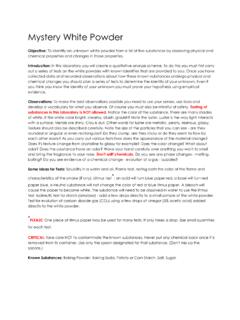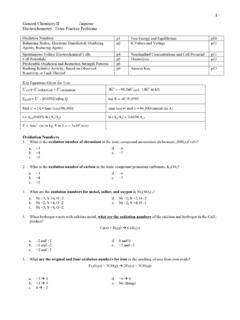Transcription of Practice Test Ch 3 Stoichiometry Name Per
1 Practice Test Ch 3 Stoichiometry Name_____Per_____. Remember, this is Practice - Do NOT cheat yourself of finding out what you are capable of doing. Be sure you follow the testing conditions outlined below. DO NOT USE A CALCULATOR. AP Chem does not allow the use of a calculator for the MC part of the exam, so it is time to start practicing without one. You may use ONLY a periodic table. While you should Practice working as fast as possible, it is more important at this point in the course, that you Practice without a calculator, even if it slows you down.
2 Look for the easy math common factors and rough estimation do not do long division to try to get exact values. Remember it is a MC test, use the answers Mark which questions you would like to go over when we get to school in September. 1. Balance the following equation: 5. Balance the following equation with the SMALLEST. WHOLE NUMBER COEFFICIENTS possible. Select the ___NH3 + ___O2 ___NO2 + ___H2O. number that is the sum of the coefficients in the balanced The balanced equation shows that mole of NH3 equation: requires ___ mole(s) of O2. ___KClO3 ___KCl + ___O2.
3 A. a. 3. b. b. 5. c. c. 6. d. d. 7. e. e. 8. 2. Write a balanced equation for the combustion of acetaldehyde, CH3 CHO. 6. Calculate the mass of hydrogen formed when 27 g of aluminum reacts with excess hydrochloric acid according to the balanced equation below. 2Al + 6 HCl 2 AlCl3 + 3 H2. When properly balanced, the equation indicates that ___ a. g mole(s) of O2 are required for each mole of CH3 CHO. b. g a. 1 c. g b. 2 d. g c. e. 12 g d. 3. e. 5 7. How many grams of nitric acid, HNO3, can be prepared from the reaction of 138 g of NO2 with g H2O. according to the equation below?
4 3. What is the total mass of products formed when 16 grams of CH4 is burned with excess oxygen? 3NO2 + H2O 2 HNO3 + NO. a. 32 g a. 92. b. 36 g b. 108. c. 44 g c. 126. d. 62 g d. 189. e. 80 g e. 279. 8. Which of the following statements is true? 4. Write a balanced equation for the combustion of propane, C3H8. I. The molar mass of CaCO3 is g mol 1. II. 50 g of CaCO3 contains 9 1023 oxygen atoms. III. A 200 g sample of CaCO3 contains 2 moles of CaCO3. When balanced, the equation indicates that ___ moles of a. I only O2 are required for each mole of C3H8. b.
5 II only a. c. III only b. 3 d. I and III only c. e. I, II, and III. d. 5. e. 8. Practice Test Ch3 Stoichiometry (page 2 of 2). 2 MnO2 + 4 KOH + O2 + Cl2 2 KMnO4 + 2 KCl + 2 H2O 14. A given sample of some hydrocarbon is burned completely and it produces g of CO2 and g of 9. For the reaction above, there is 100. g of each reactant H2O. Determine the empirical formula of the compound. available. Which reagent is the limiting reagent? a. CH. [Molar Masses: MnO2 = ; KOH= ;. b. C2H3. O2 = ; Cl2 = ]. c. CH2. a. MnO2. d. C2H5. b. O2. e. CH3. c. KOH. d. Cl2. 15.
6 The simplest formula for a hydrocarbon that is e. They all run out at the same time. percent hydrogen by mass is a. CH. 10. The reaction of g benzene, C6H6, with excess HNO3. b. CH2. resulted in g of H2O. What is the percentage yield? c. CH3. Molar Mass (g/mol): C6H6=78 HNO3=63 d. C2H2. C6H5NO2=123 H2O=18. e. C2H3. C6H6 + HNO3 C6H5NO2 + H2O. a. 100% 16. What mass of Al is produced when mole of Al2S3 is completely reduced with excess H2? b. 90%. a. g c. 50%. b. g d. 12%. c. g e. 2%. d. g e. 108 g 11. How many grams of H2O will be formed when g H2. is allowed to react with g O2 according to 17.
7 When a sample of an unknown mineral was 2 H2 + O2 2 H2O dissolved in acid, of CO2 were generated. If the a. g rock contained no carbonate other than MgCO3, what was b. g the percent of MgCO3 by mass in the limestone? Molar mass (g/mol): MgCO3 = 84 and CO2 = 44. c. g a. 33%. d. g b. 50%. e. g c. 67%. d. 80%. 12. When g of H2 reacts with g of O2 in an explosion, the final gas mixture will contain: e. 100%. a. H2, H2O, and O2 18. Which of the following represents the correct method for b. H2 and H2O only converting g of copper metal to the equivalent c. O2 and H2O only number of copper atoms?
8 D. H2 and O2 only 1 10 . 23. a. 11 . e. H2O only 1. 13. g of metal carbonate, containing an unknown metal, 1 . b. 11 . M, were heated to give the metal oxide and g CO2.. MCO3(s) + heat MO(s) + CO2(g) 1 . c. 11 . What is the identity of the metal M? 10 23 . a. Mg 10 . 23. b. Pb d. 11 . 1 1. c. Ca d. Ba 1 1 . e. 11 . e. Cr 10 23 . Practice Test Ch3 Stoichiometry (page 3 of 3). 19. The mass of element X found in mole of each of four 2Ca3(PO4)2 + 10C + 6 SiO2 P4 + 6 CaSiO3 + 10CO. different compounds is g, g, g, and 70 g, 22. Elemental phosphorus can be produced by the reduction respectively.
9 The possible atomic weight of X is of phosphate minerals in an electric furnace. What mass a. of carbon would be required to produce mol of P4 in b. the presence of 1 mol of calcium phosphate and 3 mol of c. silicon dioxide? d. a. 2 g e. b. 12 g c. 24 g N2(g) + 2O2(g) N2O4(g) d. 60 g 20. The above reaction takes place in a closed flask. The e. 120 g initial amount of N2(g) is 8 mole, and that of O2(g) is 12. mole. There is no N2O4(g) initially present. The 23. In which of the following compounds is the mass ratio of experiment is carried out at constant temperature.
10 What is element X to oxygen closest to to 1? (The molar mass the total amount of mole of all substances in the container of X is g/mol.). when the amount of N2O4(g) reaches 6 mole? a. X5O2. a. 0 mole b. X3O2. b. 2 mole c. X2O. c. 6 mole d. XO2. d. 8 mole e. XO. e. 20 mole 6H+ + 5H2O2 + 2 MnO4 5O2 + 2Mn2+ + 8H2O. 21. Given that there are two naturally occurring isotopes of 24. According to the balanced equation above, how many gallium, 69Ga and 71Ga, the natural abundance of the 71Ga moles of the permanganate ion are required to react isotope must be approximately completely with ml of M hydrogen peroxide?











